Commentaries Topics: Federal Budget
Commentaries /
Budget 2024: Capital gains pains
Budget 2024: Capital gains pains
“Today, after weeks of pre-budget spending announcements on housing, defense, artificial intelligence and more, the government finally answered the questions of “how much will this all cost? And who’s going to pay for it?”.
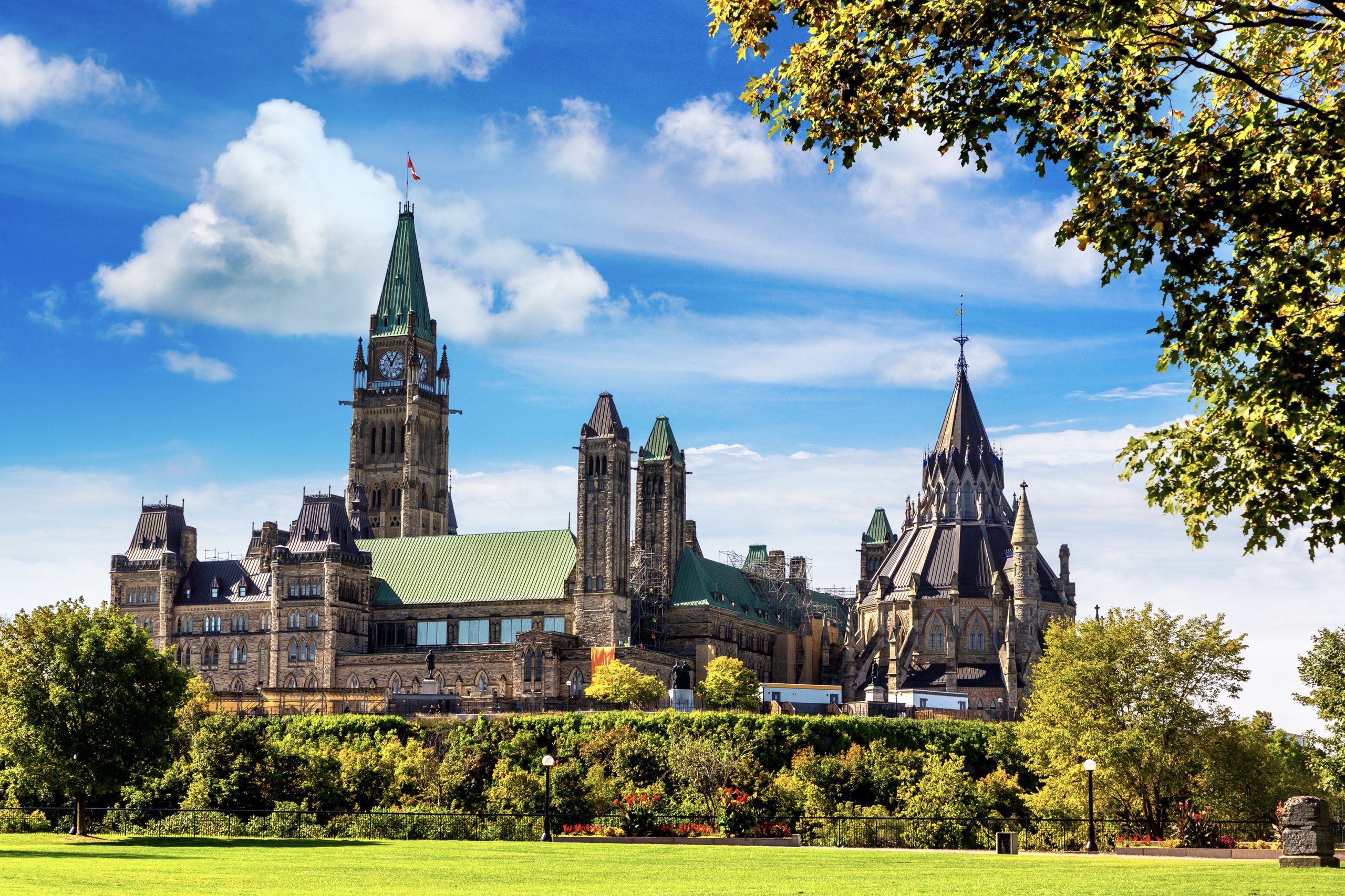


Business Data Lab
“Today, after weeks of pre-budget spending announcements on housing, defense, artificial intelligence and more, the government finally answered the questions of “how much will this all cost? And who’s going to pay for it?”.
Budget 2024 puts the total bill for all new measures at $57 billion dollars over the projection period. It turns out that those with capital gains may feel more pain (as raising the inclusion rate is expected to bring in more than $19 billion over the projection). And while inflation may be hurting the government in the polls, it continues to provide some fiscal room to help offset new spending. The remainder of the bill falls to the government’s bottom line and the taxpayers’ tab, as the deficit is expected to be a cumulative $10 billion higher over the projection.”
KEY TAKEAWAYS
- Budget 2024 Context: Facing the highest inflation in a generation, central banks have aggressively raised interest rates to restrain demand. Inflation is slowing, although still not back to target, while the global economy has thankfully avoided a recession.
The U.S. economy continues to defy expectations. For its part, Canada’s economy has displayed resilience, but remains fundamentally fragile with strong population growth flattering headline numbers and reducing real GDP per capita.
Even with slower inflation, overshooting prices mean that affordability remains a central preoccupation for many consumers, especially younger Canadians.
Business bankruptcies have started to rise after emergency government programs ended, which had provided a pandemic pause.
Interest rates in Canada are expected to start coming down this summer, but with the strong U.S. economy, rates globally may stay higher-for-longer than markets have been expecting. - Some Economic Tailwinds: In this context, Canada’s private sector economists continue to see a soft landing, featuring modest growth as inflation slowly returns to Bank’s 2% target. And while inflation is clearly unpopular, and may be hurting the federal government in the polls, it continues to pay dividends for Ottawa’s bottom line.
The private-sector economic forecast in Budget 2024 provides some fiscal room to help with policymakers’ recent spending announcements. The forecast not only incorporates better near-term economic growth prospects (which are unwound over the projection); but more consequentially, higher GDP inflation (a positive shock from 2023 carries forward into 2024 and isn’t unwound).
As a result, the path for nominal GDP — the broadest measure of the government’s tax base — is up nearly $40 billion (or 1.2% on average) over the projection.
The Budget suggests that the latest private-sector survey is reasonably cautious (as its weaker than several other notable organizations such as the Bank of Canada, PBO, OECD and IMF). They nonetheless include downside and upside scenarios. As a rough “stress-test” the books, Canada suffers a shallow recession in the downside scenario.

- New Policy Measures: In the recent weeks, the government rolled out a series of announcements on housing, defense spending, artificial intelligence and more. The big question that was answered today is “how much is all of this going to cost?”
Budget 2024 puts the price tag at roughly $57 billion in new measures over the projection period. This nets out to nearly $40 billion, after taking account of new tax measures (which are expected to bring in $18 billion).
There are numerous ways to break down these moves. I put them into the following categories:- Defense: $10.7B for military and equipment
- Generational measures: $10.6B for various measures including launching the Canada Disability benefit; pharmacare; school food program and more.
- Indigenous Peoples: $9.1B including education, infrastructure, health care and policing.
- Housing: $8.5B for a wide variety of measures to address the housing crisis.
- Other: $14.1B which includes support for artificial intelligence, research,
various investment tax credits (EV supply chain; clean electricity; clean tech manufacturing), as well as renewed funding for the Chamber’s Business Data Lab. - Tax measures: $18.2B largely focused on “taxing the rich” by raising the inclusion rate on capital gains above $250k annually (from 50% to 66.6%), among other measures.

- Fiscal Outlook: New spending measures more than take up the room coming from the somewhat better economic outlook. As a result, the deficit is now expected to be a cumulative $10B higher over the projection.
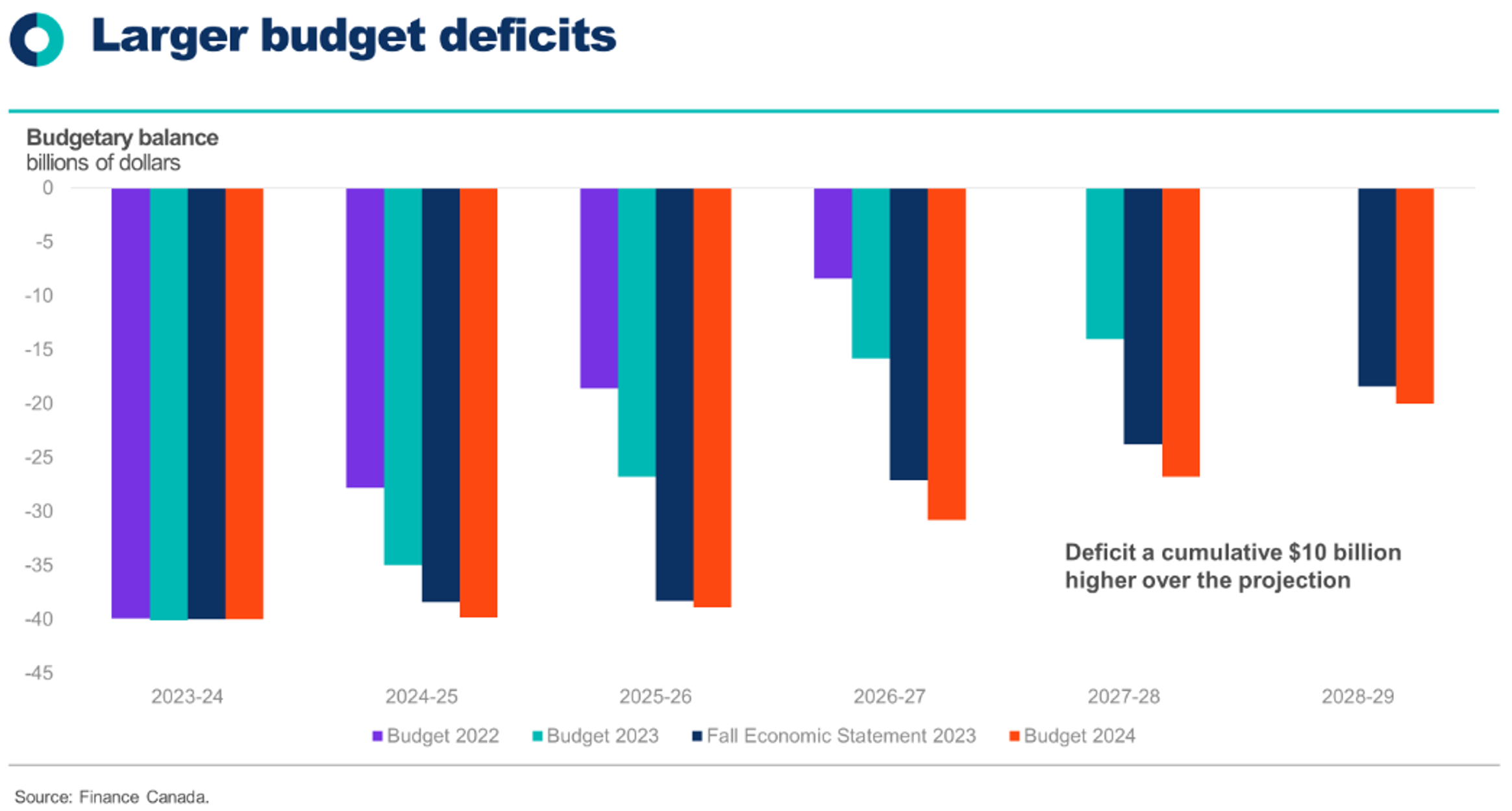
- For context, the federal deficit is expected to come in around $40 billion for the fiscal year that just ended. This amount is expected to remain relatively stable for the next two years before showing a more noticeable decline starting in 2026 and continuing thereafter. These deficits remain manageable as a share of GDP (even in the downside scenario), but the lack of a return to balanced budgets will still cause concern for fiscal hawks. Deficits are expected to shrink modestly each year as a share of GDP, from 1.3% this year, trending in the 1% range, and ending the forecast at 0.6%.
- Debt: The federal debt is expected to rise by more than $150 billion over the projection, reaching $1.4 trillion five years out. As a share of GDP, federal debt starts at 42%, declining slowly to 39% in 2028.
- “Fiscal anchors” and long-run sustainability: The 2023 Fall Economic Statement introduced several fiscal objectives, all of which Budget 2024 is able to check off, namely:
- In absolute terms, to keep the 2023-24 deficit at, or below, the $40.1 billion projected in Budget 2023.
- Lower the debt-to-GDP ratio in 2024-25, relative to the Fall Economic Statement, and keep it on a downward track thereafter; and finally
- Maintain a declining deficit-to-GDP ratio in 2024-25, and keep deficits below 1% of GDP in 2026-27 and future years.
Looking further out, Finance Canada’s long-term projections show the status quo federal debt ratio on a steady decline over the next 30 years, even in the downside scenario. This should be taken with a few grains of salt, however, since it assumes no additional spending beyond status quo measures, which has not been the historical experience.
More Fiscal Charts





Other Commentaries

Oct 19, 2022
September 2022 Consumer Price Index data: Food and services prices still rising, no progress on core inflation

Sep 20, 2022
August 2022 Consumer Price Index data: Finally some good news on Canadian inflation.

Aug 16, 2022
July 2022 Consumer Price Index data: Canada’s inflation finally turns a corner with falling gas prices, but core pressures remain
Commentaries /
Budget 2023: Mo’ Problems; Mo’ Money
Budget 2023: Mo’ Problems; Mo’ Money
The 2023 federal budget is a signal that a mild recession is still in the cards. Slowing growth and higher interest rates have put the federal government between a rock and a hard place. A key takeaway here is just how hard it is to craft effective fiscal policy in the shadow of the pandemic, supply chain disruptions, and the war in Ukraine.



Stephen Tapp

The 2023 federal budget revised down the economic outlook and now incorporates a mild recession in Canada this year. But that didn’t stop the government from introducing another $43 billion in net new initiatives over the projection. For Canadian businesses there are mixed signals in this budget: on the one hand, the government is encouraging private-sector investment in the green economy and taking a harder look at previous spending commitments; but on the other hand, the government is introducing new taxes that will discourage economic activities for high-earners and businesses.
Stephen Tapp, Chief Economist, Canadian Chamber of Commerce
KEY TAKEAWAYS
- Difficult Context: Budget 2023 comes at a difficult time. The lingering pandemic is still having adverse economic impacts. Russia’s war is raging in Ukraine. Geopolitical tensions risk balkanizing global supply chains, all while recent financial market turmoil has increased uncertainty.
Here at home, Canadian businesses and consumers are struggling with rising costs and affordability challenges. Our economy faces long-standing competitiveness and growth challenges, as the world moves towards a net-zero economy. The combination of slowing growth and higher interest rates brings new fiscal headwinds. All told, it’s a tough time to be a fiscal policymaker.
- Weaker Economic Outlook: Not surprisingly, the private-sector economic forecast was downgraded in Budget 2023.

This primarily reflects two factors:
- First and most consequential for the fiscal projection,with weaker global growth and softer commodity prices, Canada’s GDP inflation forecast was lowered for this year (from 1.8% to 0.6%).
- Second, and more likely to attract headlines, Canada’s forecasters now expect a mild recession featuring three consecutive negative quarters of growth to start 2023. If realized, this would be a shallow recession (if not a soft landing, certainly “softish”) with real GDP growth only lowered from 0.7% to 0.3% this year.
This double-whammy is effectively a one-time hit for the economy that drags down the expected pathfor nominal GDP — the broadest measure of the government’s tax base — by an average of $60 billion (or 2%) over the projection. So fiscal policymakers face a worse starting point.
- New Measures: With the weaker economic outlook, the federal government appears to be rethinking and reallocating many previous spending commitments, but they didn’t hesitate to ramp up spending. Budget 2023 adds roughly $43 billion in net new measures over the six-year projection period (i.e., after accounting for new tax measures and spending reallocation). While there are many ways to break down these moves, I “follow the money” to identify five big-ticket categories

- Health care (with additional transfers to provinces/territories) and dental care (scaling up the new program) were the biggest combined area of new spending at more than $31 billion.
- Next is the roughly $16 billion for various investment tax credits to help spur private-sector investment to build Canada’s clean economy — ostensibly the government’s response to recent and massive green subsidies south of the border.
- While the tax credits should encourage companies to invest, on the other side of the ledger are new tax measures worth $14 billion targeting high-earning companies and individuals. This included movement on the global minimum corporate tax (part of the OECD’s two-pillar approach, along with renewed commitment to impose a digital sales tax, if needed), revamping the “alternative minimum tax” on high-earners, and new taxes on share buybacks as well as bank dividends. These measures are likely to discourage economic activity on the margin.
- Right behind the tax moves are the many budget line items that total around $13 billion which also help the government’s bottom line by reallocating previous spending in many areas and departments (including spending cuts for external consultants and government travel).
- Finally, I lumped a variety of “other” moves together with a total price tag of over $25 billion. This includes reconciliation, affordability (with another one-time top-up of the GST credit for lower-income households, in this case notionally directed to groceries).
- Fiscal Outlook: With a weaker economy and net new spending, the fiscal outlook worsened.
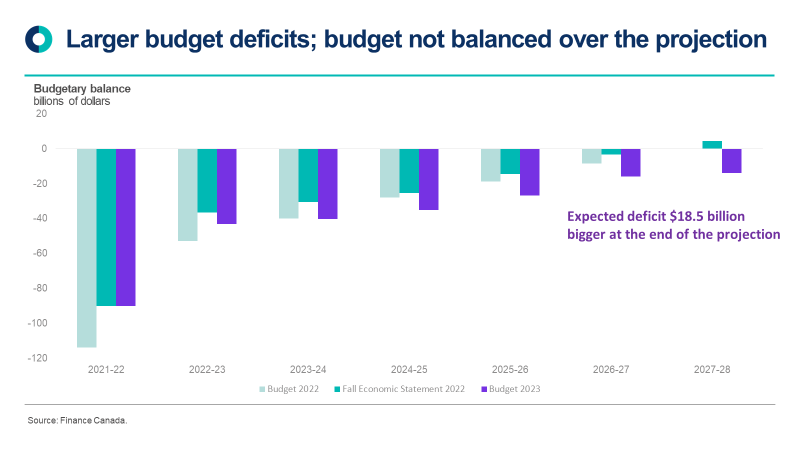
- Deficits: The federal deficit is $18.5 billion bigger by the end of the projection. Notably, the government abandoned its plans to balance the budget over the projection. As a share of GDP, deficits remain manageable, but are still likely to concern some fiscal watchers. These deficit ratios are expected to shrink modestly each year from 1.5% in the current fiscal year, trending around the 1% range, and ending the forecast at 0.4% of GDP.
- Debt: Federal debt increased by $132 billion over the projection to $1.3 trillion five years out. As a share of GDP,federal debt starts at 42%, and is expected to rise a few percentage points over the next few years, before ending the forecast modestly improved at 40% in 2027-28.
- Fiscal anchors and long-run sustainability: Previously, the government stated its “fiscal anchor” was to: 1) unwind COVID-related deficits; and 2) reduce the federal debt ratio over the medium term. Budget 2023 dropped any reference to deficit elimination. In its baseline scenario, the federal debt ratio is expected to rise for a few years but is anticipated to eventually fall over this projection. However, in the downside forecast scenario, the debt ratio is higher for four years, and is only modestly improved by the fifth year.Looking further out, Finance Canada’s long-term projections show the status quo federal debt ratio is on track to decline steadily over the next 30 years, even in the downside scenario. However, this assumes no additional spending beyond the status quo, but in reality, this government has tended to increase spending in each successive budget. Moreover, the Parliamentary Budget Office estimates that the outlook is notably weaker for the provinces, given their increased exposure to health care costs which are expected to rise as the population ages.
- Risks: Given the elevated level of uncertainty, this budget included an upside and a downside scenario. The forecaster survey occurred in February before the recent financial market turmoil. At this point, it looks like Canadian real GDP will be positive in Q1 2023, but a recession remains a real risk (probably a 50%-65% likelihood in 2023). If global conditions deteriorate further, it’s easy to imagine scenarios far worse than the downside scenario modelled. That said, this constitutes a reasonable basis for fiscal planning. But I see the risks still tilted to the downside, just like they were in Budget 2022.
MORE FISCAL CHARTS

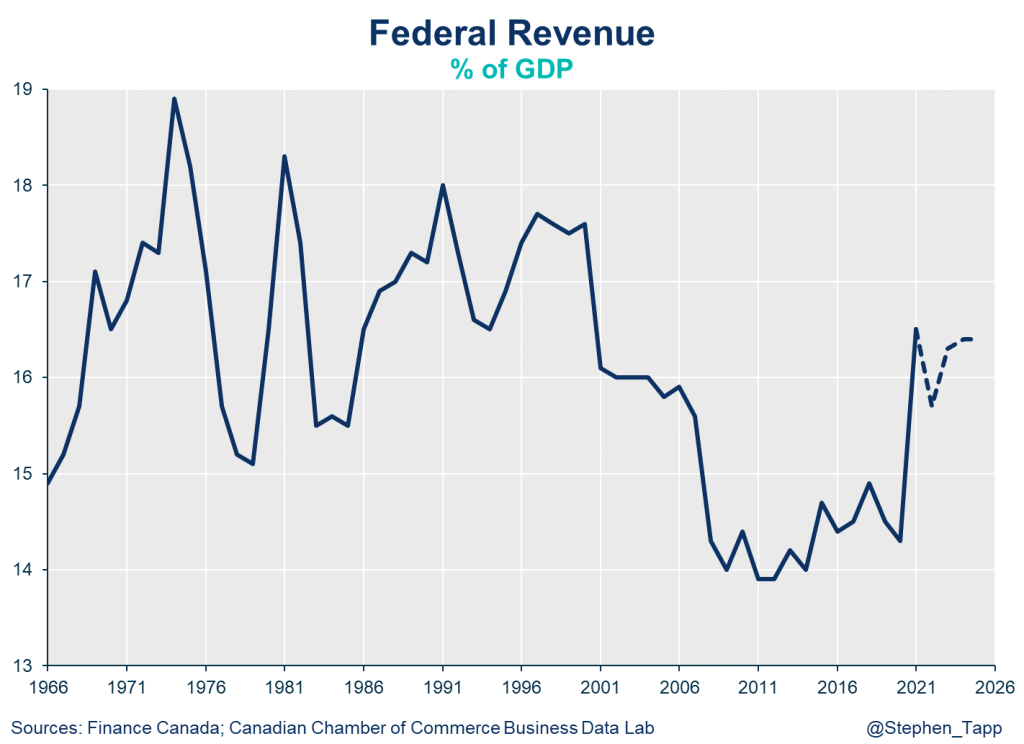
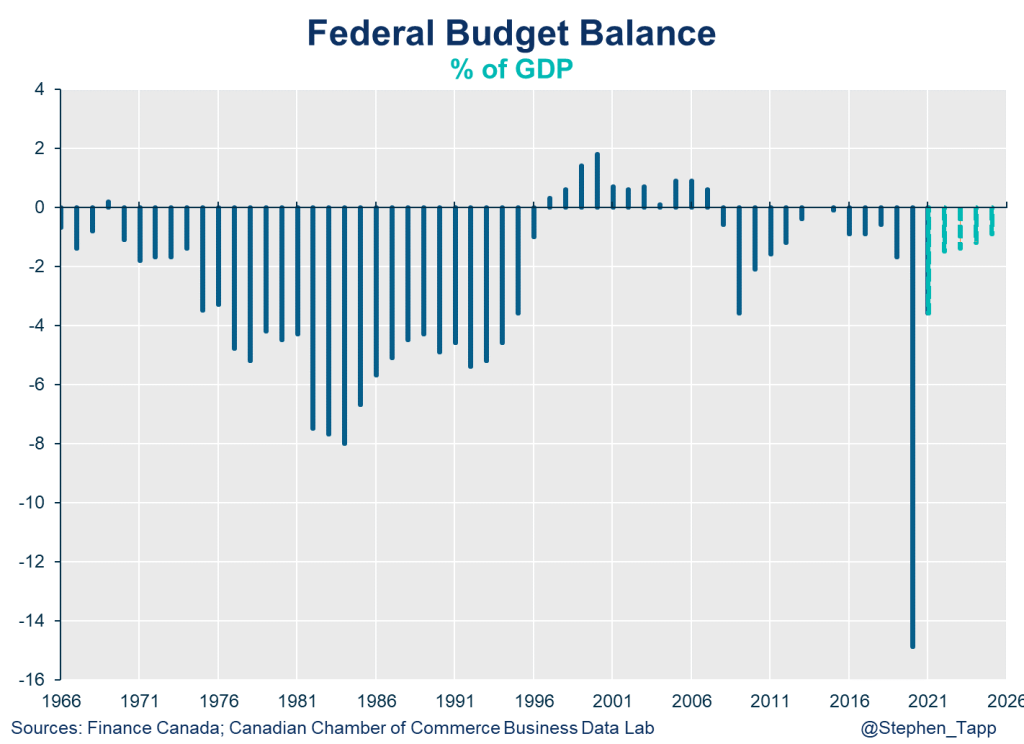
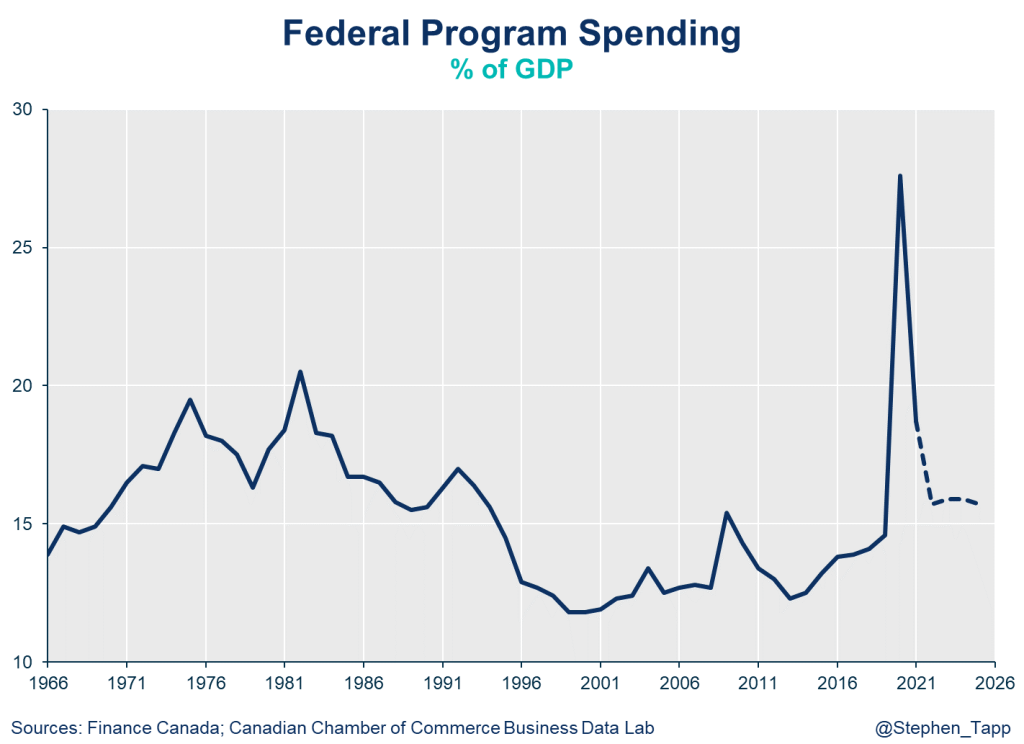

Other Commentaries

Oct 19, 2022
September 2022 Consumer Price Index data: Food and services prices still rising, no progress on core inflation

Sep 20, 2022
August 2022 Consumer Price Index data: Finally some good news on Canadian inflation.

Aug 16, 2022